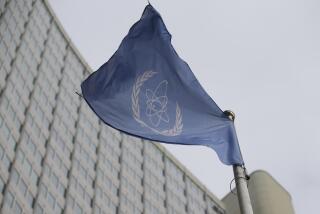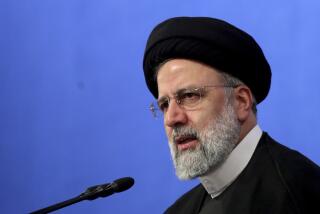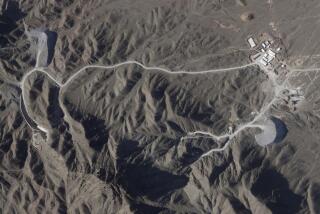Iran has technical means to make nuclear bomb, IAEA says
Reporting from Washington — United Nations nuclear inspectors have concluded that Iran has acquired the technical means to design a nuclear weapon and would require about six months to enrich uranium to the quality needed for a bomb if it decided to do so, according to officials familiar with the evidence.
Evidence of advances in Iran’s research is expected to emerge this week in a report by the International Atomic Energy Agency, the U.N.’s Vienna-based nuclear watchdog.
The IAEA report provides no “smoking gun” proof that Iran’s government intends to build a nuclear weapon, said a European diplomat. But the report is likely to add pressure on the Islamic Republic, and bolster those who have called for stiffer sanctions or military strikes in an effort to prevent Iran from becoming a nuclear-armed state.
Iran insists its nuclear program is only for civilian purposes, and Iranian officials suggest documents buttressing the U.N. report are forged.
The report cites previously undisclosed evidence indicating that Iranian scientists secretly developed nuclear technology after 2003, despite a widely publicized U.S. intelligence assessment in 2007 that Iran had halted such work four years earlier.
Iran’s decades-old nuclear program “was cut way back” in 2003, “but some parts, we think, continued,” said David Albright, a former U.N. nuclear inspector who has reviewed internal U.N. documents on Iran.
Albright said IAEA inspectors believe that Iran “has sufficient information to design and produce a workable implosion nuclear device” using highly enriched uranium.
Iran received assistance in the past from Pakistan and North Korea, but new intelligence indicates a Russian scientist, identified in published reports as Vyacheslav Danilenko, also provided help in the mid-1990s. “He is thought to have helped them build a much smaller nuclear weapon design,” Albright said.
The IAEA also obtained a document in which Iranian scientists discussed plans to begin in 2007 a four-year study of neutron initiators, which are sophisticated detonators.
“The date 2007 is also disturbing, because it would confirm that Iran has continued to work on nuclear research linked to a military application,” the European diplomat said.
White House spokesman Jay Carney declined to discuss the IAEA’s upcoming quarterly report on Iran, but other officials said they expected it to be far more critical than previous reports.
In recent days, Israel’s government has denied news reports that it was planning a strike against Iran’s known nuclear sites. British and U.S. officials disputed a report in the Guardian newspaper that London and Washington were preparing joint military action.
James R. Clapper, the director of national intelligence, told a congressional hearing in February that U.S. intelligence agencies “continue to assess Iran is keeping the option open to develop nuclear weapons in part by developing various nuclear capabilities and better position it to produce such weapons, should it choose to do so. We do not know, however, if Iran will eventually decide to build nuclear weapons.”
For now, Albright said, U.S. intelligence officials believe they can detect if Iran begins a crash program to enrich uranium of sufficient purity to provide fuel for a nuclear device.
But Tehran is moving parts of its nuclear operation into underground facilities for protection against aerial surveillance and airstrikes. “They’re in it for the long haul, and the thing they have to do is create a capability to make weapons-grade uranium faster and also in secret,” Albright said.
Special correspondent Julia Damianova contributed to this report.
More to Read
Sign up for Essential California
The most important California stories and recommendations in your inbox every morning.
You may occasionally receive promotional content from the Los Angeles Times.











